He has been doing it for four years: Organising a tour to Bordeaux for a small group of wine enthusiasts. In the past for the Coburg Adult Education Centre, this year for a group from the wine forum of Wein-Plus.
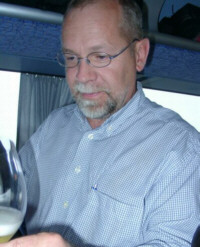 |
| Max Hendlmeier |
"He" is Max Hendlmeier, born in 1953 and regional spokesman of the German Sommelier Union for Upper and Middle Franconia. He has been a wine lover and leader of many wine seminars for many years. If you make an appointment with him and are 5 minutes late, you will get to know one of his distinct sides: A penchant for perfectionism and his sense of punctuality; but this in an unobtrusive and pleasant manner that one learns to appreciate very much when travelling in a group. That is certainly one of the things that links him to the châteaux lords in Bordeaux. They say that punctuality is also the top priority here. If you get hold of one of the coveted appointments and are only a few minutes late, you forfeit your "visiting rights" and stay outside the door. Or so they say. Thanks to Max Hendlmeier's unobtrusively perfect preparation and organisation, we did not have to make this experience.
All in all, the trip benefited from Max Hendlmeier's perfect organisation. Even in the run-up: nothing is left to chance. Even the seats in the bus, which with a capacity of only 25 out of 44 seats comfortably accommodated everyone, were precisely marked out and distributed on a plan. The long journey to Blois - our first stage destination - was constantly enlivened by information material about our destinations. First, a travel folder with information and texts for the first day. A loose-leaf collection, so to speak, which was supplemented every day with more pages about the next day. Gradually, a tourist guide to Blois, a guide to the Grand Crus of Bordeaux, a map of Bordeaux, a gourmet booklet with an inlay on the city of Bordeaux and many other brochures and information were distributed.
Despite the long bus journey, there was no boredom. The trip was enlivened by a video about Bordeaux. And - an experience made again and again was confirmed - you quickly get into conversation with other wine enthusiasts, so that the bus trip actually flew by.
The medieval town of Blois lies in the middle of the 500 ha Touraine wine-growing region, a wine-growing area on the middle Loire. Red wines dominate here (main grape variety: Gamay). The white wines grown here are mainly Sauvignon Blanc and Chenin Blanc.
Our Hotel De France & Guise is located in the middle of the old town. Sufficient sleeping comfort is offered in historically dusty rooms. Breakfast (baguette, jam, butter) was enlivened by the hectic and thus all the more amusing efforts of the staff to explain an over-consumed place setting with the help of various counting attempts and tally sheets.
The drive from Blois to Vouvray was via the road on the right bank of the Loire instead of the motorway. The loss of time can only be recommended, you get much more of the landscape that way.
In Vouvray, we visited Philipe Gaultier's Domaine du Clos des Aumônes and had the opportunity to taste the Chenin Blanc wines typical of this region. The farm does not give the impression of one of those "showcase farms" where you wonder if people are actually working there. Everything is somehow a bit chaotic. Gaultier leads us through a total of five current white wines from his range. The wines had a decent price/performance ratio, generally under 5 euros. By far the best was a sparkling wine, the 99 method traditional demi-sec with a crystal clear nose, hints of green apple and butter. On the palate, a beautiful melting style with present acidity and pronounced minerality as well as clear residual sugar.
Bistro du SommelierThe name proclaims a bistro that could be particularly pleasing to us wine lovers. Indeed: the menu is a wine list with interspersed dishes. These are calculated in an uncomplicated way. The price is simply based on the number of courses. Three courses cost only around 20 euros. What you get served for that is fantastic. High-quality cuisine attractively arranged. A pleasure!The wine list with about 250 different positions, mainly Bordelais growths. The bottle from 10 euros for decent drinking wines up to 647 euros for a 94 Petrus Open wines were not mentioned on the menu. Which was not a problem with our group size of 14 people. If the weather permits, you should make a reservation at the back of the garden. A beautiful spot with lots of plants and cosy bistro tables on several levels. Bistro du Sommelier, rue G. Bonnac 163, tel: 0556967178, closed Saturday noon and Sunday. |
Bordeaux - a name for a region, a city and of course for the most famous wine-growing region in the world. We stay at the Novotel in Bordeaux-Lac, a district of Bordeaux facing the Médoc.
The city of BordeauxThe city tour on Sunday fell on the first Sunday of the month. This is the car-free Sunday in Bordeaux. So we took a "round walk" through the centre with our Dutch guide. A new mayor has been in power in Bordeaux for 6 years. After the last mayor had let the city fall asleep for 46 years, according to our guide, a clearly noticeable dynamic has broken out since then. The city is being provided with a completely new tram network (14 km), the old sandstone facades are being renovated and cleaned; everywhere in the city you come across building sites. It makes one really curious to return in 5 or 10 years to see the result of this renovation process. It is certainly no coincidence that the start of this gigantic investment took place at a time when the prices of Bordelais wines were beginning to climb to astronomical heights. The town has naturally benefited from this wealth.... |
The drive from Bordeaux-Lac to Paulliac first leads through a rather unspectacular landscape. Only slowly do "vineyards" appear. There is actually no question of mountains, as the vines in the Médoc generally only slope westwards towards the Gironde on very flat slopes. Our first destination is Pichon-Longueville Baron. This estate, which at the time was the result of the division of a joint estate with Pichon-Longuevile Baronesse, was built from scratch in the early 1990s.
 |
In front of the majestic château, which is now uninhabited, are the cellars. These appear relatively inconspicuous from the outside, as much of the facilities are underground. The new building is based on designs by architects Patrick Dillon and Jean Gastines from 1988, and the style of the cellars is correspondingly modern. Everything is designed with visitors in mind. The fermentation cellar can be seen through windows from the entrance area. The bottling plant can be viewed from a gallery - without any risk to hygiene or damage to the equipment by too curious visitors. The 1,500 barriques are stored in the barrique cellar, perfectly arranged for viewing. The tour was pleasantly competent and also very honest. We didn't experience any "winegrower's Latin" for wine tourists, but rather there was open discussion about the winemaking technique. Even the concentrator was not a taboo subject. "Why should we renounce methods that improve the wine?" was the sympathetic guide's answer to the question whether must concentration is an issue for Pichon-Longueville. When we asked whether the egg whites are beaten for clarification in the winery, we received only a brief "so please". It was explained to us that this had long since ceased to be common practice in Bordeaux and that most wineries only tell tourists about this. Nowadays, powder or other industrially produced protein products are used for this.
We tasted the two 98s from the estate. The second wine Les Tourelles de Longueville and the first wine of the estate.
In the afternoon, a very big name was on the agenda: a noticeable contrast to the highly technical Pichon-Longueville Baron, the Château Mouton Rothschild, which was subsequently elevated to Premier Cru. The approach is unspectacular, as is the entrance area. First we watched the obligatory slide show for visitors, in which Baroness Philippine Rothschild enlightened visitors about the history and present of Mouton Rothschild as well as the affiliated wineries of the Mouton empire. All in all, a well-made film, well, perhaps quite helpful to get in the mood.
Tradition is what is shown and conveyed to the visitor in the guided tour. No steel tanks, the old cellar with thick mould on the walls. Finally, the in-house museum with valuable historical material about winemaking and wine enjoyment; presented in style. Johnson even calls this museum the "largest museum with works of art on the subject of wine in the world".
We couldn't resist the question whether must concentration was used. Did she really not know what she was talking about? Was she unsure what she was allowed to say? In any case, the calm manner of our guide was broken for a moment. We did not get an answer. No matter, it was impressive to see this winery with our own eyes for once. The only thing missing was the key to the baroness' private wine cellar, which we could see through the grille with our mouths open: There are 120,000 bottles stored here; a large part of them from a traditional annual exchange of 12 bottles each between the leading estates in Bordeaux.
In the tasting, we were presented with 2001 barrel samples from d'Armailhac, Clerc Milon Rothschild and, of course, Mouton Rothschild. In any case, the d'Armailhac was very disappointing; I do not dare to judge the other wines at this early stage. Mouton Rothschild was, to my mind, surprisingly accessible and, on balance, unimpressive.
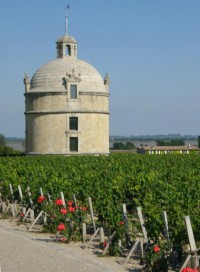 |
| One of the most expensive vineyards in France. Here, the square metre of land hits you with at least 500 euros. |
The tour is followed by a photo-shooting tour according to the motto "Médoc in two hours". But you simply must have seen them, the temples of the wine lover Cos d'Estournel, Lafite, Latour and Pichon Comtesse.
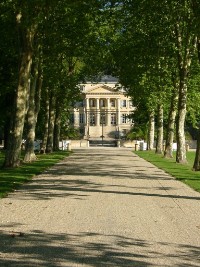 |
| The imposing entrance to Chateau Margaux |
The visit to Château Margaux was a highlight of the trip. Anyone who has the opportunity to visit this chateau should take it. Three wines are produced here on 90 ha: Pavillon Blanc, Pavillon Rouge and the famous Premier Cru Châteaux Margaux. The estate belongs to the Mentzelopoulos family, who acquired it in 1977. Since then, Margaux has been consistently at the top. It is located in the appellation of the same name, Margeaux. It is unique in the Medoc that appellation and château name are identical.
With the 1999 and 1997 vintages, we were allowed to taste those vintages which - although not among the leading vintages in Margaux - were impressive. Both were among the wine highlights of our entire tour.
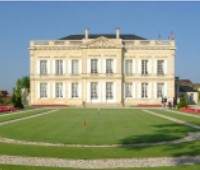 |
| The "most beautiful lawn in Bordeaux" in front of Gruaud Larose |
St Julien is "one of the most consistent, reliable and undervalued regions in the Haut-Medoc", as Max Hendlmeier writes in the tour notes. Our example of this region is Château Gruaud Larose. The estate has had a chequered history in terms of its owners. It was founded in the 18th century, divided up in the 19th century and reunited in 1934. After a sale in 1995, it was sold to the current owner, the Bernard Taillan group, in 1997. These changes had no influence on the quality and consistency. On 82 ha, 60% Cabernet Sauvignon, 20% Merlot and 10% Cabernet Franc, 10% Petit Verdot grow.
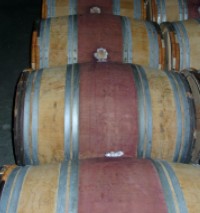 |
| Barriques with the typical red colouring between the middle barrel ripening. For optical reasons, this is created with the help of a sponge and some residual wine to conceal the unavoidable stains around the bunghole. |
We were shown the production facilities very clearly. From the bright, modern grape reception to the fermentation vessels made of wood and concrete to the barrique cellar. Steel is taboo at the castle. Instead, modern concrete tanks are used for the second wine and wood for the first wine.
Of course, the 2002 vintage is also mentioned during this tour. Like everywhere else, people are still hoping for a few sunny weeks until the harvest. After the past weeks, which were very rainy, a great vintage is hardly to be expected anyway.
We tasted a barrel sample of the first wine of 2001, where the long maceration period resulted in a very dense colour and a firm tannin structure. However, the tannin quality also reveals the problems of the vintage.
The Golden Lion - where the winegrowers dineThe Lion d'Or restaurant is an address that enjoys a lot of attention in the region. Is it because of the lively owner Paul Barbier? Is it the special feature that everyone is allowed to bring their own wine without having to pay a corkage fee? Is it because of the little cupboards with glass doors and the little brass plates with the names of well-known and less well-known châteaux in the area? By the way, these are each filled with a few bottles of these châteaus. The respective producers have a key to their cupboard and use it to take out one or two bottles when they come here to dine. The food was good, but it's certainly not the only reason for the week-long reservation times you have to put up with here.The menu consisted of salmon in emulsified tarragon sauce, veal nut roasted whole with pommes Maxime, cream puff stuffed with baked apple and vanilla ice cream on a sauce of apple, vanilla and white wine. The menu was very classically made and without any big gimmicks. A real treat for the palate. |
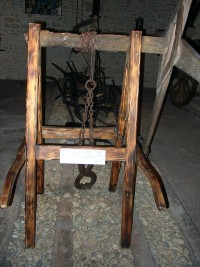 |
| Ancient equipment for pulling vines in the museum of Maucaillou |
The Moulis region, further from the Gironde, is the smallest appellation in the Médoc. It is not the home of the classified growths, but of the Cru Bourgois. One of these is Château Maucaillou. With 55 ha, Maucaillou is rather one of the larger producers in the region. The museum is interesting for the visitor. There, historical equipment is displayed that was used in the vineyard and cellar in the past. Processes are vividly shown and explained, such as the production of corks or barriques. A special installation makes it possible to take odour samples of the "smells in the Maucaillou" and to assign them with the help of buttons - unfortunately only labelled in French. However, most of the showpieces are labelled in several languages (including German), so that even those unfamiliar with the language can easily find out more. This did not apply to the film, which - similar to the one at Mouton - is practically a must-see for visitors. The chairs are comfortable and one can rest for 15 minutes. The film uses as an analogy to the art of winemaking an aged conductor who conducts classical music with great commitment and enthusiasm. In stark contrast to this was our young guide, who completed her obviously very tiresome compulsory programme with the tour. I don't know if it was the impression of the unsuccessful tour or really the wine. In any case, we were not particularly convinced by the 97 Maucaillou we tasted.
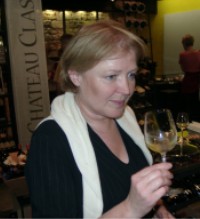 |
| Bergitta Reiss |
Quite different was a tasting at a relatively well-known consignor in Germany, Château Classic. The extremely charming and sympathetic Bergitta Reiss moved to the Medoc at some point out of annoyance at the difficulties of buying Bordeaux wines in Germany and has since been supplying German and European wine lovers with the region's growths from there. Two years ago Hawesko took over shares in Château Classic. This laid the foundation for further expansion. In particular, activities in the internet business are to be significantly expanded in future.
In the recently acquired shop in St. Julien de Beychevelle, she presented us with several Médoc wines in the price range of around 20 euros each. Especially worth mentioning: Petit Bocq from St. Julien 1999. Dense nose, very present, ripe tannins. Long. About 90 points. For just over 20 euros, this wine is certainly a recommendation, as is a visit to the wine shop in general.
We have Bergitta Reiss to thank for organising the evening. A visit to " La Mayne Lalande", a Cru Bourgois from Listrac-Moulis. In the fermentation cellar, which at least at the time of our visit would have benefited from a little more of the cleanliness experienced at other producers, Bernhard Lartigue explained to us how, according to Lartigue, "you make a good wine". The extensive explanations in French about closeness to nature and the uniqueness of the Bordelais wines, which are "unique in the world in this quality", were increasingly summarised by Bergitta Reiss. I don't think anyone was sad about this "loss of information". The zeal and enthusiasm with which Lartigue makes his wines is palpable. Separated from the beautiful barrique cellar by a large glass door, we took the opportunity to taste his wines from the vintages 1998 to 2000. These wines for less than 20 euros were prime examples of the fact that it is still possible to find bargains once you are in the region among the classified growths. Particularly impressive, by the way, was the 2000, which I rated at around 93 points. (1999: 89 points, 1998: 91 points).
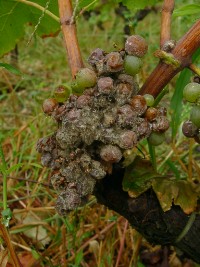 |
| Much too early (beginning of September) these grapes were attacked by botrytis. They will probably have to be selected in a fortnight |
Wine lovers associate this name with one type of wine in particular: the noble sweet wine made from Sémillon and Sauvignon Blanc, characterised by botrytis (noble rot) and produced with minimal yields. While the yields of the top red wines in the Médoc are around 30-40 hl/ha, producers in Sauternes have to be content with yields between 5 and 15 hl/ha. The climate in Sauternes is characterised by the cold Ciron, which flows into the warmer Garonne. The resulting fog causes the grapes to be attacked by noble rot (Botrytis cinerema) at the end of the ripening period. This causes the grapes to shrivel up in the vineyard and gives the wine its characteristic aroma.
The undisputed top producer in the appellation and at the same time "the" name for sweet wine worldwide is Château d'Yquem. We visit a direct neighbour of d'Yquem, Château Raymond-Lafon. The estate belongs to Pierre Meslier, the former director of Château d'Yquem.
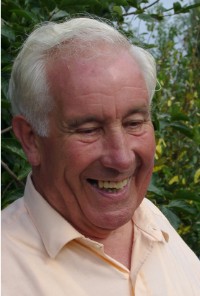 |
| "Many years ago, America was discovered..."% with these words, we get a short training on reblaus-resistant rootstock vines. His conclusion: "The feet are American% but the head is and remains French" |
We experience in him a charismatic, committed person whose heart is in the vineyard. The tour also begins there. Between the Sauvignon Blanc on the right and the Sémillon on the left, we learn about the importance of these grape varieties for Sauternes wine: The Sauvignon with about 20% for the grape aroma and the Sémillon, susceptible to noble rot, for the botrytis aroma and the associated sweetness levels.
Raymond Lafon is virtually surrounded by Yquem vines. The conditions on the "highest vineyard in Sauternes" should be correspondingly high quality. It is, Meslier adds with a laugh, "80 metres high". The estate is not included in the 1855 classification. "At that time, the vineyard was too young," Meslier says by way of explanation. The consumer is of course spared the unfortunately usual cru surcharge on the price!
We tasted the 98. A very pure wine with freshness and liveliness. One could believe to find the lively Pierre Meslier in this wine. At 25 euros for half a bottle and certainly over 90 points, a recommendation and a good alternative to the well-known names in Sauternes.
From Bordeaux southwards along the Garonne stretches the Premier Cotes de Bordeaux region. The red wines are now more important there than the white wines. It is a rather unknown area that is not known for tops.
 |
| Jens Böhme shows us around the estate |
It is all the more astonishing that it was here that the Bremen-based group Reidemeister & Ulrichs got involved in 1989 and acquired the Château du Grand Moueys in Capian. Since then, this estate has experienced an upswing. Investments in the vineyards and the cellar became possible. The market position in Germany was thus also secured. Today, the estate exports about 20% of its wines to Germany via R&U.
Jens Böhme, the sales manager who comes from Germany, took over the tour. We get to know a winery that uses the most modern technology in traditional rooms. 100% mechanical harvest with subsequent selection on a conveyor belt as well as fermentation in stainless steel are keywords that underline this.
The tasting takes place in the rooms of the castle in a pleasant atmosphere with an extensive buffet. The white wines (the fresh Grand Moueys Bordeaux Blanc Sec, ditto aged in barrique) as well as the very simple second wine les Templiers form the beginning of the tasting. This is followed by the more sophisticated first wine from 1997, which is well worth the money at 12.50 euros ex estate.
Similar to Premier Cotes Bordeaux, Graves is also an appellation that stands for both red wine and white wine. Part of Graves has had its own appellation since 1987: Pessac-Leognan. Here, Château Pape-Clément has made a special name for itself alongside Chevalier, a very old vineyard that is particularly known for its red wines. According to Max Hendlmeier, this is the château with the "oldest continuous history in Bordeaux". It was established in the year 1300. The winery is located in the middle of the city of Bordeaux, where land is inevitably becoming more and more expensive and scarce. Today, in addition to 2.5 ha for white wine, the estate has a total of 30 ha of red wine, 60% of which is Cabernet Sauvignon and 40% Merlot.
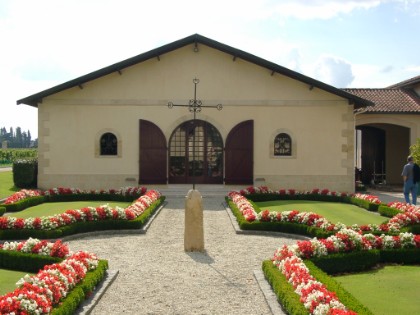
The white wine (Sémillion, Sauvignon, Muscat) is left on the lees until shortly before bottling. A bâtonnage ensures regular contact with the yeast. After Betonit fining and a light filtering, the wine is bottled. It was a pity that we could not taste the white wine. However, we were compensated by the 93 Pape Clément first wine. Ripe beguiling fruit aromas, smoke, tobacco and leather aromas. A wine with a lot of power and at an already drinkable age. Of course, the latter did not apply to the subsequent barrel tasting of the 2001 vintage, even though it is still noticeably above the 93 in quality.
In recent years, there has been a continuous switch from stainless steel to wood as the fermentation vessel. The grapes are de-stemmed by hand and elaborately hand-selected.
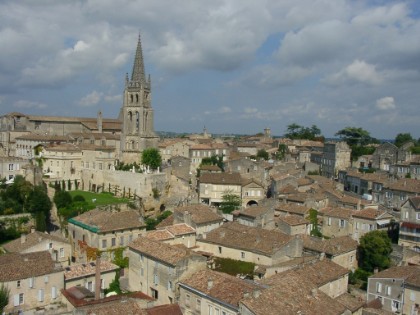 |
| View of the medieval town of St. Emilion |
The tranquil little town of St. Emilion gave its name to what is probably the best-known appellation on the right bank of the Gironde. St. Emilion has its own classification system. At the top are the 11 Premier Grand Cru Classés, including 63 Grand Cru Classés. The vineyards of the estates in St. Emilion are - compared to the Médoc - relatively small. On average, the Premier Grand Cru Classés have a vineyard area of less than 20 ha. The dominant grape variety here, as on the entire "right bank", is Merlot.
Château Canon la Gaffelière is a Grand Cru Classee just outside the town of St. Emilion. Since 1971, the estate has belonged to the German family Count Neipperg. Since 1985, the estate has been run by Stephan Neipperg. Since then, the quality has been more consistent. Also owned by the Neipperg family and managed together with Canon la Gaffelière is the top estate La Mondotte, which covers only 4.5 ha, as well as the Grand Cru Peyreau, Clos de l'Oratoire and Château d'Aiguilhe.
 During the guided tour at Canon la Gaffelière, we experience an estate that, unlike the châteaux in the Médoc, resembles more a bustling complex than a representative castle. From here, Stephan Neipperg directs the fortunes of his estates in St. Emilion. From his office, he looks out over his vines, which, as is common throughout Bordeaux, are introduced by rose bushes. Somewhat annoyingly, we are served the "rose fairy tale" here. Allegedly, the rose bushes are still used for the early detection of diseases. This has long since become nothing more than a legend. In fact, roses used to be used for the early detection of downy mildew. The roses are attacked more quickly than the vines, so in the past the winegrowers were able to recognise in good time that the vines were also threatened by an infestation. Nowadays there are far more reliable methods. The roses have only one purpose: ornamentation and - unfortunately also at Gaffelière - a reason to tell tourists a pretty story.
During the guided tour at Canon la Gaffelière, we experience an estate that, unlike the châteaux in the Médoc, resembles more a bustling complex than a representative castle. From here, Stephan Neipperg directs the fortunes of his estates in St. Emilion. From his office, he looks out over his vines, which, as is common throughout Bordeaux, are introduced by rose bushes. Somewhat annoyingly, we are served the "rose fairy tale" here. Allegedly, the rose bushes are still used for the early detection of diseases. This has long since become nothing more than a legend. In fact, roses used to be used for the early detection of downy mildew. The roses are attacked more quickly than the vines, so in the past the winegrowers were able to recognise in good time that the vines were also threatened by an infestation. Nowadays there are far more reliable methods. The roses have only one purpose: ornamentation and - unfortunately also at Gaffelière - a reason to tell tourists a pretty story.
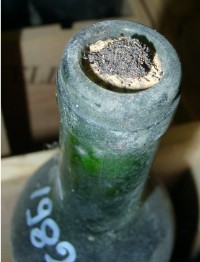 |
| Old bottles% that had to be discarded% because they were infested with the notorious cork moth. In the meantime, the corks are protected from encapsulation by special plastic coatings. |
As a special feature, we get to know a process that has been finding its way into cellars for a few years now, the so-called micro-oxidation. In this process, oxygen is injected into the wine in doses with the help of special nozzles during the ageing process. Here, this is not done in stainless steel tanks, but in barriques. This makes the souterage, the racking of the wine every few months in new barriques, superfluous. Micro-oxidation leads to wines that are ready to drink more quickly. A possible negative influence on the shelf life is disputed.
From the Neipperg wines we were allowed to taste the following barrel samples from 2001
Château d'Aiguilhe, Clos de l'Oratoire, Canon la Gaffelière as well as La Mondotte.
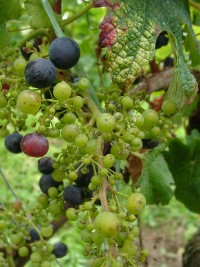 |
| Rieslings on a Cabernet Franc vine that is about 30 years old. In 2002, such trickling will probably reduce the yield on the estate considerably. |
The other well-known appellation on the right bank is Pomerol. The landscape is charmless, or as Max Hendlmeier puts it about the wines from Pomerol in his travel documents: "...their splendour and fame rests more on themselves than on the landscape from which they come".
Merlot also dominates in Pomerol. We visit the producer of a so-called "garage wine" Château Guillot-Clauzel. Here, the wine from only 1.7 ha is vinified and bottled. The first wine Château Guillot-Clauzel and the second wine Château Graves Guillot are produced from 60% Merlot and 40% Cabernet Franc.
The above-ground "cellar" could easily fit into two somewhat larger double garages. In the first "garage" are a few fermentation tanks, in the second "garage" the barriques and a small bottle store.
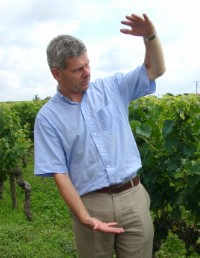 |
| "This is how deep the ground is ploughed% when old vines are replaced by new vines." |
In the second room we learn quite a bit about the philosophy of Madame Clauzel, or rather our guide. He is a believer in letting nature largely take its course and accepting that different vintages produce different wines. "I think making a perfect wine is totally stupid",... "A wine has to be human". He clearly criticises efforts on some estates to produce a wine that is as identical as possible every year. This is only possible with a great deal of technology. As an example, he mentions micro-oxidation in the barrique, the process that was described to us a few hours earlier at Gaffalière as particularly forward-looking.
Our tour through the Bordeaux wine-growing regions ends with a short detour to Petrus, certainly the most famous estate in Pomerol. After a final dinner (see below) and another overnight stay, we will return to Germany by bus. We already knew from the outward journey that this would not be boring...
 |
| The whole group in the vines of Petrus |
Another report on the trip in the wine forum